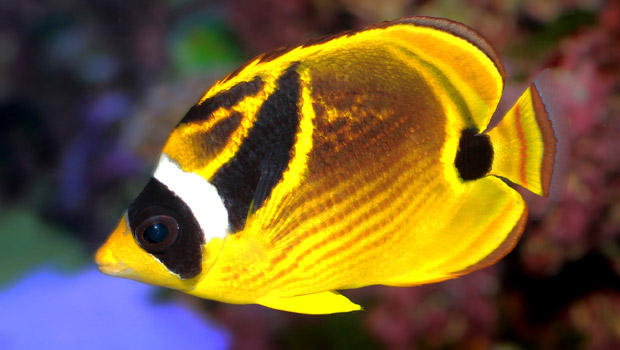Raccoon Butterflyfish

The raccoon butterflyfish, Chaetodon lunula, is one of the most recognized butterflyfishes in Hawaiian waters. It was named in English for the North American mammal that also has a black face mask. This fish’s Latin name means “crescent”, referring to the bold markings at head and tail. The Hawaiian name, kīkākapu, is shared with several species of butterflyfishes and suggests some sacred reference; like many butterflyfishes, it was not commonly eaten.
This species ranges throughout the Indo-Pacific, from the tropical coast of East Africa to Micronesia and Polynesia, north to southern Japan and south to Australia’s Lord Howe Island. It feeds on a wide variety of soft-bodied invertebrates including sea anemones, worms, nudibranchs, and occasionally coral polyps and algae. Familiar to snorkelers and divers, it is seen in pairs or aggregations on shallow reef flats and to depths of at least 75 feet (22.5 m). Some researchers report it as a night active species. The raccoon butterflyfish reaches lengths of 8 inches (20 cm).
Butterflyfishes are perhaps the most familiar of reef fishes. To many people, these colorful fish are synonymous with coral reefs — active and brilliantly colored. Most butterflyfishes are found in tropical, shallow waters, around coral reefs at depths of less than 60 feet (18 m). But, some newly-discovered species are restricted to deeper reef habitats, to 600 feet (180 m) or more. Roughly 123 species are currently known; 25 occur in Hawai‘i.
Flittering movements and conspicuous color patterns reminiscent of butterflies may have earned this group their name. Researchers propose several possible functions for the dramatic colors and patterns of primarily yellow, black and white. For many butterflyfishes, especially closely-related species sharing similar habitat, species recognition may be important when identifying a mate. Some species live in pairs and defend a territory — their “poster coloration” may make them more conspicuous to intruders. For others, the coloration may confer some degree of protection from predators. The black mask at the head conceals the eye and the black marking near the tail may be a “false eyespot”. Predators that mistakenly strike at the tail, rather than the head, may lose their prey. Butterflyfishes are principally day active, and seek shelter close to the reef at night. Many species assume a nocturnal color pattern that is duller than their day-time colors; others, possibly pair-bonded or territorial species, have dramatic black/white contrast markings at night.
Ichthyologists classify butterflyfishes in the Family Chaetodontidae, named for their tooth design. All have comb-like teeth and are primarily carnivores, but diet varies from species to species. Reef-associated species, like the raccoon butterflyfish, have a broad diet and prey on different kinds of soft-bodied invertebrates. Corallivores have a specialized diet of coral polyps or mucus, and these species often maintain territories. A few butterflyfishes are planktivores, feeding above the reef and plucking individual planktonic animals from the water column.
Quick Facts
Hawaiian name
kīkākapu
Scientific name
Chaetodon lunula
Distribution
Indo-Pacific, including Hawai’i
Size
to 8 inches (20 cm) in length
Diet
reef invertebrates
Support the Aquarium
Contact Us
Honolulu, HI 96815
(808) 923-9741
Search
- Already a Volunteer?
- Click Here To Sign In


 Donate
Donate
